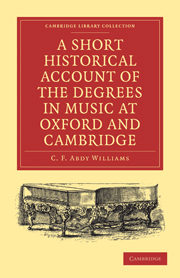 A Short Historical Account of the Degrees in Music at Oxford and Cambridge
A Short Historical Account of the Degrees in Music at Oxford and Cambridge Book contents
- Frontmatter
- PREFACE
- Contents
- CHAPTER I THE ORIGIN OF ACADEMICAL DEGREES IN GENERAL
- CHAPTER II THE EARLIEST RECORDS OF DEGREES IN MUSIC
- CHAPTER III EARLY MUSICAL STUDY AT THE UNIVERSITIES.—BOETHIUS
- CHAPTER IV THE MUSIC ACT, MUSIC SPEECH OR LECTURE, AND MUSIC SCHOOL
- CHAPTER V THE ESTABLISHMENT OF PROFESSORS OF MUSIC AT THE UNIVERSITIES
- CHAPTER VI DEVELOPMENT OF THE MODERN REQUIREMENTS FOR MUSICAL DEGREES
- CHAPTER VII THE CULTIVATION OF MUSIC AT THE UNIVERSITIES
- CHAPTER VIII ACADEMICAL DRESS.—DEGREE CEREMONIES, FEASTS.—AN EARLY EXAMINATION FOR THE B.A. DEGREE
- CHAPTER IX OXFORD GRADUATES IN MUSIC, WITH BIOGRAPHICAL SKETCHES
- CHAPTER X CAMBRIDGE GRADUATES IN MUSIC, WITH BIOGRAPHICAL SKETCHES
- APPENDIX: CONTAINING ACCOUNTS OF THOSE PERSONS WHO ARE MENTIONED IN HISTORY AS GRADUATES, BUT WHOSE NAMES DO NOT APPEAR IN THE UNIVERSITY RECORDS
- INDEX
CHAPTER VIII - ACADEMICAL DRESS.—DEGREE CEREMONIES, FEASTS.—AN EARLY EXAMINATION FOR THE B.A. DEGREE
Published online by Cambridge University Press: 05 October 2010
- Frontmatter
- PREFACE
- Contents
- CHAPTER I THE ORIGIN OF ACADEMICAL DEGREES IN GENERAL
- CHAPTER II THE EARLIEST RECORDS OF DEGREES IN MUSIC
- CHAPTER III EARLY MUSICAL STUDY AT THE UNIVERSITIES.—BOETHIUS
- CHAPTER IV THE MUSIC ACT, MUSIC SPEECH OR LECTURE, AND MUSIC SCHOOL
- CHAPTER V THE ESTABLISHMENT OF PROFESSORS OF MUSIC AT THE UNIVERSITIES
- CHAPTER VI DEVELOPMENT OF THE MODERN REQUIREMENTS FOR MUSICAL DEGREES
- CHAPTER VII THE CULTIVATION OF MUSIC AT THE UNIVERSITIES
- CHAPTER VIII ACADEMICAL DRESS.—DEGREE CEREMONIES, FEASTS.—AN EARLY EXAMINATION FOR THE B.A. DEGREE
- CHAPTER IX OXFORD GRADUATES IN MUSIC, WITH BIOGRAPHICAL SKETCHES
- CHAPTER X CAMBRIDGE GRADUATES IN MUSIC, WITH BIOGRAPHICAL SKETCHES
- APPENDIX: CONTAINING ACCOUNTS OF THOSE PERSONS WHO ARE MENTIONED IN HISTORY AS GRADUATES, BUT WHOSE NAMES DO NOT APPEAR IN THE UNIVERSITY RECORDS
- INDEX
Summary
A few words on the use of Academical costume, and its connection with the ordinary dress of the Middle Ages, may not be out of place.
In the twelfth century the ordinary gown worn by men was like that of the Lord Mayor of London, and it had a hood attached to it. It came into use after the Norman Conquest. Besides the gown, or cloak, a capa, or cape, was used, consisting of a short hooded cloak, which also came from Normandy; and many out-door garments seem to have been furnished with a hood. In the thirteenth century the hood became a separate article of attire, under the Norman name of chaperon and aumusse, later amess. The latter came to be used as a canonical vestment, though by no means limited to this, for it was worn by women for three centuries, contemporaneously with the chaperon. It went out of fashion in France about 1330, but remained long after that among the lower orders in England.
The chaperon worn by men in the reign of Edward II. was a sort of pointed bag, with an oval opening for the face; the point was sometimes of great length, hanging down behind or wrapped round the head. The tail was called a tippet or liripipes. In the first half of the fourteenth century a great variety of hoods was worn, both by men and women; and it is probable that about this time the dress and hood proper to each degree began to be settled at the Universities.
- Type
- Chapter
- Information
- A Short Historical Account of the Degrees in Music at Oxford and CambridgeWith a Chronological List of Graduates in that Faculty from the Year 1463, pp. 57 - 63Publisher: Cambridge University PressPrint publication year: 2009First published in: 1893


